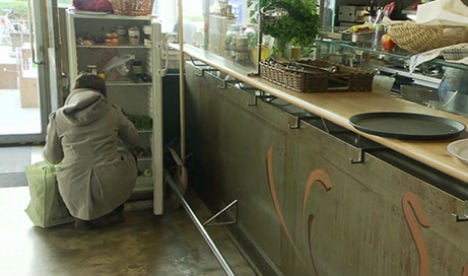In 19 locations around the city fridges can be found in which people are invited to put food that they would otherwise throw away – and also take whatever they find in the fridge.
Vienna resident Walter Albrecht has started dropping off food at one of the fridges – including spreads and vegetables which are still fresh. The idea is a great way to make sure any food in the fridge isn’t wasted if you’re about to go on holiday, for example. Companies are also invited to donate any food or drink that would otherwise go to waste.
The fridge project is similar to an already established and successful book sharing scheme in Vienna, where people can drop off unwanted books and take any they fancy reading.
The fridge idea was entered into an Austria-wide competition called ‘Orte des Respekts’ (Places of Respect) and was selected as regional winner in Vienna. The €2,000 prize money has enabled the team to buy new refrigerators which have been placed in offices, cafes and other public buildings. They will be maintained by an organization called foodsharing.
Andrea Beltrame, one of the brains behind the ‘Fair-Teilen’ (fair-sharing) concept, says the refrigerators are already a success: “They are being used by a wide variety of people… including students, pensioners, and single mothers on low incomes. They are probably also being used by homeless people.”
Christian Köck, one of the judges of the competition, says he’s excited about the project and plans to use the fridges himself. “There’s so much food we as a family don’t eat – because we’re going on holiday for example, so it just makes sense to drop it off at one of the fridges.”
The fridges can be found in the following locations:
1st District: BioWerkstatt, Biberstraße 22 (Open Mon-Fri, 9am-6pm).
2nd District: Salon am Park, Krakauer Straße 19 (Open Tues-Fri, 7.30am-7pm and Sat 8am-8pm).
3rd District: VHS Landstraße, Hainburgerstraße 29 (Open Mon-Fri 9am to 9pm).
4th District: Argus Fahrradbüro, Frankenberggasse 11 (Open Mon-Fri 2pm-7pm and Sat 10am-2pm)
Schikaneder, Margaretenstraße 22-24 (Open Mon-Sun 6pm-4am)
Verein M.U.T., Rechte Wienzeile 37 (Open Mon-Fri 10am-4pm).
5th District: Heavy Pedals, Am Hundsturm 1 (Open Tues-Fri 10am-1pm and 2pm-6pm).
7th District: Amtshaus Neubau, Hermanngasse 24-26 (Open Mon-Wed and Fri 6am-5.30pm)
7*Stern Kulturzentrum*Cafe, Siebensterngasse 31 (Open Tues-Sun 10am-2am)
8th District: Der Greissler unverpackt ehrlich, Albertgasse 19 (Open Mon-Fri 10am-6pm and Sat 8am-6pm)
Greisslerei 8, Strozzigasse 27 (Open Tues-Thurs 8am-7pm, Fri 9am-12pm)
10th District: Private residence, Köglergasse 11 (garage) – opening hours to be agreed
11th District: Private residence, Sedlitzkygasse 14 – opening hours to be agreed
14th District: R.U.S.Z, Lützowgasse 12-14 (Open Mon & Wed 9am-5pm, Tues & Thurs 9am-7pm, Fri 8am-1pm)
15th District: Verein Login, Weiglgasse 19 (Open Mon-Fri 10am-4pm)
17th District: Zur Allee, Schwarzenbergallee 40, Open 24/7
Das Jetzt, Parhamerplatz 16 (Open Mon-Sat 6pm-4am, Sun 6pm-2am)
22nd District: VHS Donaustadt, Bernoullistrasse 1 (Open Mon-Thurs 9am-7.30pm, Fri 9am-7pm)



 Please whitelist us to continue reading.
Please whitelist us to continue reading.